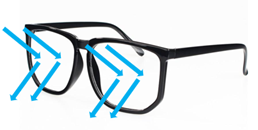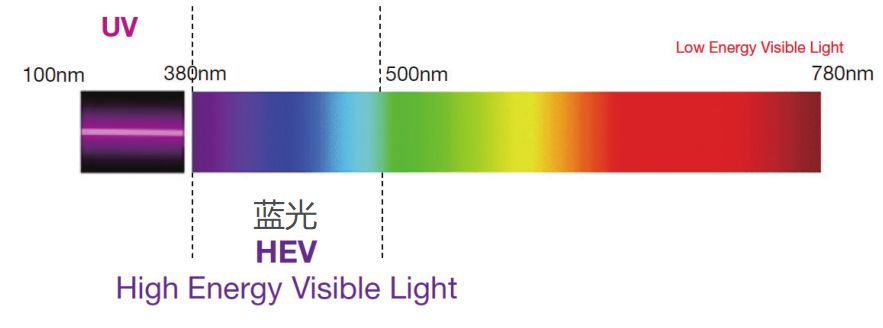People often ask if they need to wear a pair of blue-blocking glasses to protect their eyes when looking at their computer, pad or mobile phone. Did myopia laser correct after the operation need to wear anti blue ray glasses to protect the eye? To answer these questions, a scientific understanding of blue light is needed first.

Blue light is a short wavelength between 400 and 500nm, which is an important part of natural light. It was refreshing to see the blue sky and the blue sea. Why do I see the sky and sea are blue? That's because the short wavelength blue light from the sun is scattered by solid particles and water vapor in the sky and enters the eye, making the sky appear blue. When the sun hits the sea surface, most of the waves are absorbed by the sea, while the blue light in the short wavelength of visible light is not absorbed, reflecting into the eye and making the sea appear blue.
The harm of blue light refers to that blue light can directly reach the fundus, and the photochemical action caused by exposure can damage the retinal rod cells and retinal pigment epithelial cell layer (RPE), resulting in age-related macular degeneration. But after years of research, scientists have found that only short wavelengths of blue light (below 450nm) are the main cause of eye damage, and the damage is clearly related to the time and dose of blue light exposure.
Are the LED lighting fixtures widely used in our daily life harmful to blue light? LED lamps emit white light by stimulating yellow phosphor by blue chip. Under the condition of high color temperature, there is a strong crest in the blue band of the light source spectrum. Due to the existence of blue in the band below 450nm, it is necessary to control the maximum brightness or illumination of LED within a safe range for ordinary indoor lighting. If within 100kcd·m -- 2 or 1000lx, then these products are not harmful to blue light.
The following is the IEC62471 blue light safety standard (according to the eyes allowed fixation time classification), this standard is applicable to all light sources other than laser, has been widely accepted by countries:
(1) Zero hazard: t > 10000s, that is, no blue light hazard;
(2) A class of hazards: 100s≤t < 10000s, allowing the eyes as long as 10000 seconds to look directly at the light source without harm;
(3) Class II hazards: 0.25s≤t < 100s, requiring the eyes to gaze at the light source time can not exceed 100 seconds;
(4) Three types of hazards: t < 0.25s, the eye gaze at the light source for 0.25 seconds can produce hazards.
At present, the lamps used as LED lighting in daily life are basically classified as Category Zero and Category One hazards. If they are category two hazards, they have mandatory labels (" Eyes can not stare "). The blue light hazard of LED lamp and other light sources is similar, if within the safety threshold, these light sources and lamps are used in the normal way, harmless to human eyes. Domestic and foreign government agencies and lighting industry associations have conducted in-depth research and comparative testing on the photobiosafety of various lamps and lamp systems. Shanghai Lighting Product Quality Supervision and Inspection Station has tested 27 LED samples from different sources, 14 of which belong to the non-hazardous category and 13 of which belong to the first-class hazard. So it's pretty safe.
On the other hand, we must also pay attention to the beneficial effects of blue light on the body. The scientists found that light-sensitive retinal ganglion cells (ipRGC) express opmelanin, which is responsible for non-visual biological effects in the body and regulates circadian rhythms. The optic melanin receptor is sensitive at 459-485 nm, which is the blue wavelength segment. Blue light regulates circadian rhythms such as heart rate, alertness, sleep, body temperature and gene expression by affecting the secretion of optic melanin. If the circadian rhythm is disturbed, it is very bad for human health. Blue light has also been reported to treat conditions such as depression, anxiety and dementia. Second, blue light is also closely related to night vision. Night vision is produced by light-sensitive rod cells, while blue light mainly acts on rod cells. Excessive shielding of blue light will lead to night vision decline. Animal experiments have also found that short-wavelength light such as blue light can inhibit myopia in experimental animals.
All in all, we shouldn't overstate the harmful effects of blue light on the eyes. Quality electronics already filter out harmful short-wave blue light, which is generally harmless. Blue blocking glasses are valuable only when exposed to high levels and long periods of blue light, and users should avoid looking directly at bright point sources. When choosing blue-blocking glasses, you should choose to shield the harmful short-wave blue light below 450nm and retain the beneficial blue light above 450nm in the long band.
Post time: Nov-16-2022

